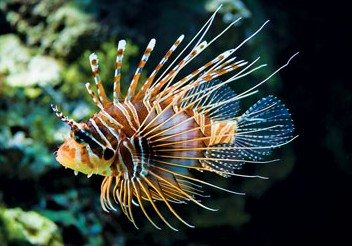A good friend and former dive student, Marvin Floyd, sent me photos of his recent dive trip to the Turks and Caicos and stated that his group saw Lionfish on every dive—but very few native species. His statement is frightening, yet unfortunately quite common now.
Alarm bells are sounding throughout the Atlantic and Caribbean. Lionfish is an incredibly dangerous, invasive species in Caribbean waters!
The beautiful yet deadly Lionfish’s native range is the Indo-Pacific. Most of the Lionfish now found in the Atlantic and Caribbean were proven, through DNA testing, to come from only three Lionfish believed to have been accidentally released from an aquarium during Hurricane Andrew in 1992.
Juvenile Lionfish have been observed as far north as Rhode Island in the United States when the water is warm, migrating south as cold weather arrives. Their year-round range now encompasses the Eastern Seaboard from North Carolina to the Keys, and south to Nicaragua. They inhabit Bermuda, the Bahamas and the Caribbean islands south to Bonaire.

Lionfish have adapted very well to conditions in the Atlantic and Caribbean and generally breed year-round. Females lay floating masses of up to 30,000 eggs several times a year. The masses remain afloat for several days and can be distributed far and wide by ocean currents.
It was once thought that Lionfish remained within relatively small territories staked out on reefs and rocky patches but that premise changed when specimens were seen swimming far out to sea in the Atlantic, between North Carolina and Bermuda.
In addition to reproducing more rapidly in the Atlantic and Caribbean, Lionfish seem to grow larger here—adults have been observed at 20 to 22 inches—than in the Indo-Pacific where the average size is 18 inches.
Lionfish are considered “top predators,” meaning there are few predators that feed on them, leaving only humans to control their populations. Dr. Mark Hixon, Mark Albins, and Tori Redinger of Oregon State University, with support from NOAA, conducted Lionfish studies in the Bahamas beginning in 2005. In 2007, they conducted a controlled study of 20 reefs, 10 reefs with Lionfish populations and 10 without. In a mere five weeks, their study showed that the Lionfish ate 80% of the native fish on the Lionfish reefs; observers documented one Lionfish eating 20 wrasse in less than 30 minutes.
Lionfish have insatiable appetites and cull very little in the way of marine life. They lie in wait on hard or sandy bottoms, or hide in crevices in reefs and rocky outcroppings. When an unsuspecting reef fish or crustacean happens by, the Lionfish swoops in with gaping mouth open, using its long tendril-like fins as fencing to contain its prey. Few escape the jaws of Lionfish with stomachs than can expand 30 times normal size. Lionfish swallow reef fish and crustaceans up to two-thirds their own size with little difficulty.
They eat the fish and crustaceans that help clean and protect the health of our reefs, they eat the fish and crustaceans upon which commercial and indigenous fishermen depend, and the young of fish upon which sport and recreational anglers depend. And in their wake they leave a wasteland of dead and dying reefs, as my friend’s photos demonstrate.
Everyone who uses the Caribbean, including swimmers, snorkelers, commercial fishermen, divers, recreational boaters and anglers, should become familiar with and able to identify Lionfish, sometimes confused with the native Scorpionfish.
Careless swimmers, waders, divers, and anglers suffer extremely painful envenomations when stuck with one of the Lionfish’s spines. A gland at the base of the open, channel-like spines releases venom that travels up the channel when pressure is applied to the spiny fins. Although the venom is not deadly, many victims state they wish they were dead as they suffer through the pain.
Our reefs and fish populations are already at great risk due to pollution, overfishing, ocean acidification, coastal development, and global warning.
Many governments and organizations in the U.S. and throughout the Caribbean are asking for the public’s help in locating and eliminating Lionfish, knowing that it will be a long-term, uphill battle and one we may not win.
Becky Bauer became a scuba instructor and award-winning journalist covering the marine environment in the Caribbean after 30 years as a wild and domestic animal rescuer, rehabber, and educator in the states. She is a contributing photographer to NOAA.
Help in this battle
- Learn the difference between our native Scorpionfish and the Lionfish.
- Look for Lionfish every time you are on or in the water.
- Obtain contact information for the local fish and wildlife department
- When Lionfish are found, make note of the number, size, and location, as exactly as possible (GPS co-ordinates are excellent if available).
- Notify the local fish and wildlife department, giving as much detail as possible regarding the sighting.
- Or, e-Mail NOAA at: reportlionfish@noaa.gov
- If you are an experienced diver, contact the local fish and wildlife agency, dive shops and dive clubs to volunteer for Lionfish hunting expeditions.
- Contact local governments and ask what procedures are in place for tracking and eliminating Lionfish. If there are none, become an activist and enlist the help of those who make their living from the sea.
NEW – Renowned Chef Captain Jan Robinson shared a Tasty Recipe for Cooking up Lionfish
CHIME IN Below with your Lionfish sightings!






Yes, this is true – I felt strongly enough to develop a website about it –
http://www.carolineswall.com/tci_lionfish_invasion/index.html
If we could only save the world’s third largest coral reef…let’s try to draw as much attention as we can to this problem.
Thanks for the comment! Great website – thanks for bringing it to our attention.